Is it your first time fly fishing for smallmouth bass? Perhaps you’ve been chasing smallies on the fly for a while, and are looking for new fly pattern ideas? Let’s look at some of the best flies for targeting smallmouth bass.
Smallmouth bass are perhaps the perfect gamefish. Not only are they pound for pound one of the strongest fighting freshwater fish, they can also be targeted in many different ways, and fly fishing is no exception. Smallmouth bass take a wide variety of flies, from streamers, topwater flies, and even nymphs.
Full disclosure. Fly selection below is based on what works, not on what looks fancy or what is popular at the moment. Keep reading below for 11 of the best streamer flies, 5 of the best topwater flies, 4 of the best dries, and 5 of the best nymphs for targeting smallmouth bass.
Streamers
Fly fishing for smallmouth bass is usually done with streamers. Bass prey heavily on both baitfish and crayfish, and streamers are what you want to use to mimic the profile and movement of these prey species.
Clouser Minnow
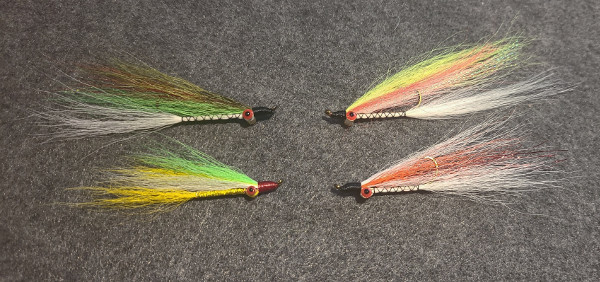
The second most widely used streamer fly in the world (second to only the woolly bugger), this pattern was actually designed specifically for smallmouth bass. The fly was designed to get down quickly to bass holding in deep and/or fast-moving water. A Clouser minnow accomplishes this through a combination of weight (the dumbell eyes), and slim profile, and sparse materials.
The fly is unique among streamers in that the dumbell eyes give it a jigging action. You can vary the weight of the dumbell eyes on the clousers minnow based on how severe a jigging action you’re looking for. I like to tie mine on the lighter side n terms of weight, as I find the subtle jigging more effective than if the fly sinks like a stone.
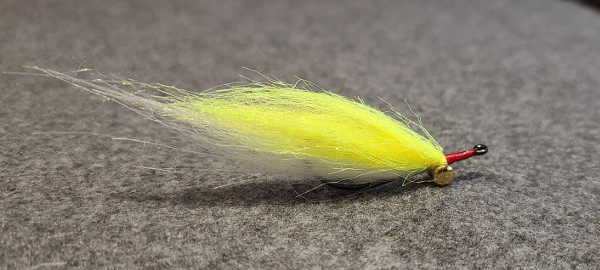
You’re not just limted to classic clousers either. High-tie clouser minnows (best tied with craft fur, or fox tail) are a variation that is also quite productive. When slowly bounced along the bottom, they mimic a minnow picking food off the riverbed.
Slump Buster
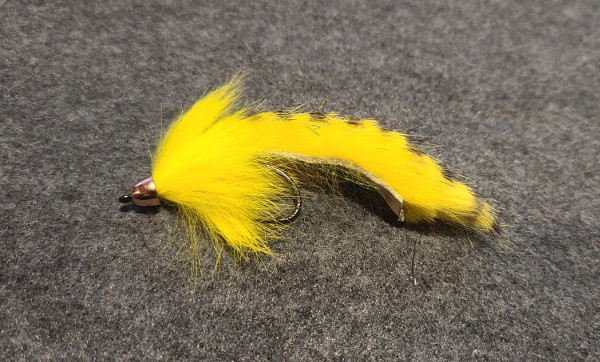
Almost half the flies in my smallmouth bass streamer fly boxes are actually slumpbusters. This is by far my personally most used fly for targeting smallmouth bass, and is often the first thing I tie on, especially if fishing new water. The rabbit hair zonker has such great action in the water. No need to bust a slump if you don’t get into one in the first place!
These are traditionally tied with coneheads. The rabbit fur offers a fair bit of resistance in the water, so the conehead helps counter this, and brings it down into the strike zone. Be careful not to use an oversized cone on your slump busters. If you overweight the fly, the action will be negatively impacted. You want the fly to remain mostly level on retrieve, you’re not looking for a jigging action with this pattern
The most productive colours for me on slumpbusters have been all white, yellow, or chartreuse. All black is productive in low-light conditions.
Zoo Cougar
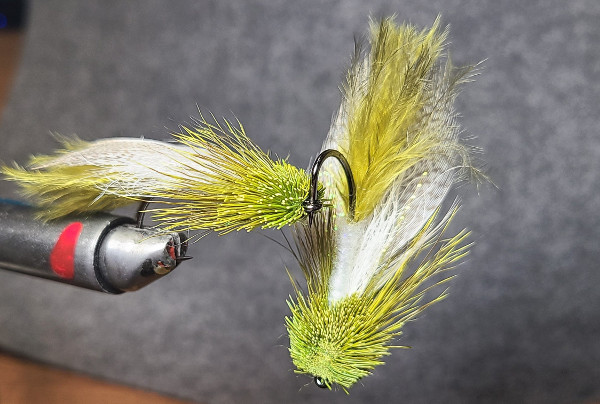
Particularly effective in fast-flowing rivers with a healthy sculpin population. Being one of Kelly Gallups patterns, this fly was tied with a specific action in mind. The fly is intended to mimic a sculpin that got knocked loose from the riverbed. Sculpins don’t have swim bladders, so they struggle to adjust their buoyancy and get back down to the bottom in these situations. Once up in the water column, sculpins get kicked around in the current quite a bit before they finally find their way back to the bottom.
The mallard flank is the key part of this fly, and is what catches the water so that the fly flutters about in the current like a sculpin in distress. The fly uses the deer hair collar to represent the prominent pectoral fines present on a sculpin.
Boogie Man
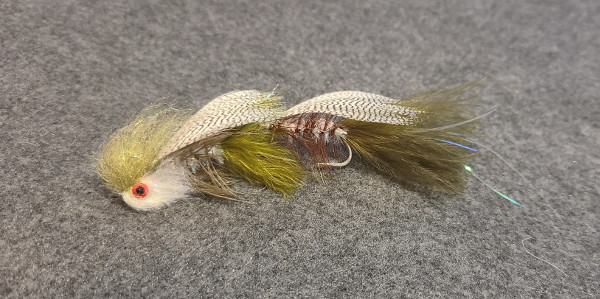
Articulated flies in general are great choices for bass fishing, especially if you’re after big bass. Among the more well-known articulated fly patterns, I’ve had the best results fishing the boogie man fly for smallmouth bass. It doesn’t look as appealing as some of the flashier flies out there, but this pattern has really good action in the water, and catches fish.
Honorable mentions for other effective articulated flies include dungeons and the barely legal fly. The barely legal is a great imitation for deeper-bodied fish such as sunfish that are common in lakes/ponds, and slower-moving bodies of water.
Articulation adds a level of movement to the fly that just isn’t possible within single hook fly patterns. There’s a reseason that jointed Rapalas are so successful in the world of lure fishing. Using Fly Tying Shanks – Amazon Link is also a great way to make a fly larger, while still only using one hook (which is required on some waters).
Woolly Bugger
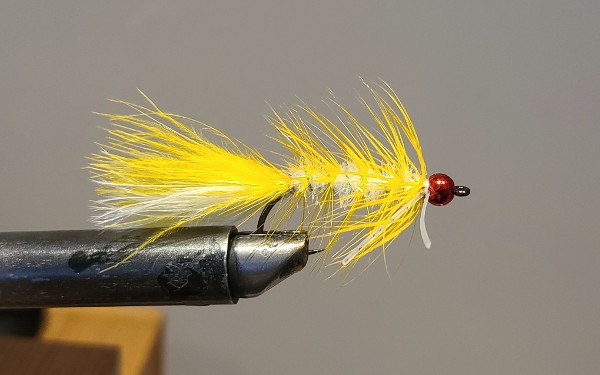
The all-time classic streamer pattern. This fly likely holds the title for the pattern that’s caught the widest variety of fish species. If not the Wooley bugger, then definitely the Clouser minnow mentioned earlier.
Is it a fish? a crayfish? a hellgrammite? Who knows, depends heavily on what colour it’s tied in. It’s one of those flies that imitates a wide variety of y items “well enough” without imitating any particular thing perfectly. It just simply looks like something a fish wants to eat.
As a bonus, they’re crazy easy to tie. There’s a good chance a woolly bugger was (or will be) one of the first flies you try to tie.
Back on the topic of chasing smallies. If I’m intending on fishing a wooly bugger to imitate a minnow, I tend to tie them white, with possibly a second colour depending on prey fish present. If I’m trying to imitate a leech, damselfly larva, crayfish, or hellgrammite (see, the fly mimics so many things!), I tend to tie buggers in either olive or black.
Swimmin Jimmy
This pattern falls somewhere between a topwater and a streamer pattern.
The front hook is bent downwards at an angle. When you strip this fly, the angled hook causes it to dive downwards, the tightly packed deer hair head then makes the fly slowly float back up to the top. This mimics the behavior of a dying fish, or a fish with a swimbladder issue. Either way, this fly mimics a baitfish in a vulnerable position, which can result in some vicious strikes. A how-to on how to tie this pattern can be found here.
For those readers chasing esox fish. This fly is an excellent choice for targeting pike or musky.
Crayfish Flies
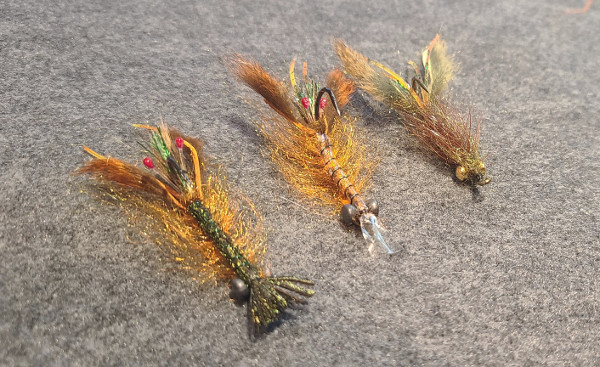
Crayfish are prey to a wide variety of fish species. From carp to pike and everything in between, and smallmouth bass are no exception.
There are so many different variations on crayfish flies, it’s hard to pick just one. Many of the better designs I’ve seen aren’t actually a named pattern, they’re just an individual fly tyers twist on a crayfish imitation. Pick a pattern that best imitates the crayfish species present in the water you’re fishing. The crayfish species in my area have quite small claws, so I tie my crayfish patterns with smaller claws than many other fly tiers do.
A really simply crayfish imitation, is just substituting the bead-head on a Wooly bugger for a dumbell eye. You can now bounce this modified fly along the bottom almost snag-free. You can also take almost any shrimp fly pattern and add claws.
Muddler Minnow
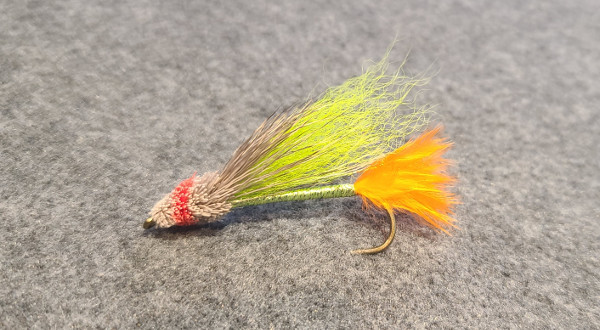
Another tried and true pattern. The muddler minnow is one of the first patterns to incorporate a sizable deer hair head. Big heads push alot of water, which makes the fly more noticeable to a fish’s lateral line.
The muddler minnows I fish are modernized a bit. I don’t use duck quill for the wing or tail as the classic pattern calls for. I use marabou or fox tail instead, which gives the fly some much-needed additional movement in the water, and a bit of a thicker profile.
Full disclosure that I’m a big fan of deer hair heads. Not only do they push water, but they also allow you to adjust the buoyancy of a pattern quite easily. Simply pack the head more tightly for added buoyancy, or more loosely for less buoyancy. I do most of my streamer fishing on sinking lines, so I like to have alot of patterns with some level of buoyancy (tending towards neutrally buoyant on most) when fishing the middle of the water column.
Zonkers
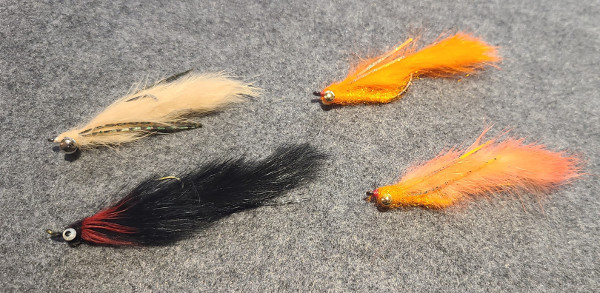
For lack of a better word, or more comprehensive pattern name, zonkers. Rabbit zonkers offer so much action just by themselves. My second most used fly after slumpbusters is a simple unnamed zonker pattern shown above.
I tie mine with dumbell eyes to ride hook up, and often put some sili legs near the front or flash out the back for some flair. Also put some dubbing or chenille on the hook shank. They can mimic crayfish or baitfish just by varying the retrieve. A bonus of this pattern is that the zonker is Texas-rigged like a senko, so it’s quite weed resistant.
The black one in the picture above also happens to be my go-to fly for nighttime walleye fishing.
Lefty’s Deceivers

An iconic streamer fly developed by Left Kreh. Designed for chasing after saltwater striped bass in saltwater. The fly works just as well when fly fishing for smallmouth bass.
Lefty’s deceiver has so much going for it. It does a great job of mimicking a wide variety of baitfish, and the design allows for flexibility in color combinations. The fly also uses minimal materials to create a good-sized profile, making it quite light, and very easy to cast. To top it all off, it’s quite easy to tie.
I tend to use these on bright days in clearer water. My go-to color combination is white and chartreuse, with a touch of red (usually the thread wraps at the front, occasionally a throat of red material instead).
Topwater
Smallmouth eat mice, frogs, and insects (we’ll get into these later) that land on the surface. Topwater flies are what you’re going to want to use to mimic these prey items. Topwater is without a doubt the most fun way to fish for smallmouth bass. A fish blowing up on a popper is one of the (many) highlights of fly fishing. Unfortunately, you can’t catch smallies on topwater all the time, conditions have to be right.
I’ve split topwater flies into two parts. “Topwater” which we’ll cover here and includes flies that mimic creatures such as frogs and mice. The other section is “dries” which are more traditional (I use that term loosely) fly patterns that mimic insects. I’ll go over these a bit further down.
Let’s get into what the best topwater fly patterns are for fishing smallmouth bass.
Gurgler
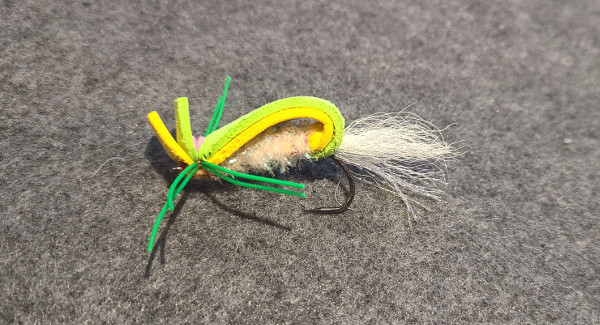
Gurglers make less noise than divers and poppers do, and offer a more finesse presentation. This is a great fly for fishing skinny water, or when targeting picky, high pressured fish.
The fly does a good job of imitating many different prey items. It’s unclear if the fish think it’s a grasshopper or a baitfish swimming along the surface. Either way, the fly works.
As an added bonus, this is quite a fun pattern to tie. When tied in smaller sizes, it works really well to target mooneye at night.
Dahlberg Diver
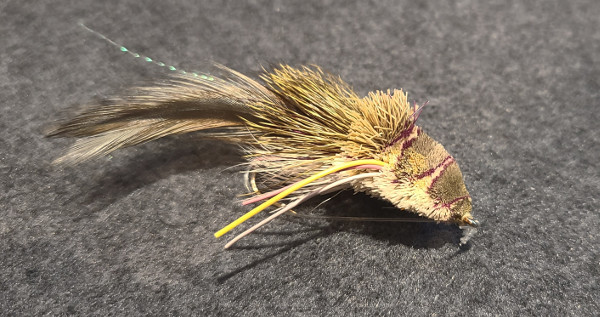
I love the action a dahlberg diver has. It floats at the surface when stationary, but the wedge deer hair head makes the fly dive down and run a few inches under the water when retrieved. This action is a fantastic imitation of how a frog swims, and is why most Dahlberg divers are tied with frog coloration.
They can also be fished to mimic an injured baitfish, similar to the Swimmin Jimmy mentioned earlier.
Most Dahlberg divers are tied with deer hair, but you can also tie these with a foam head instead. The action a Dahlberg diver gives also happens to be perfect for targeting pike. I use the foam head flies in water that also has healthy pike populations, as the foam holds up better to the teeth than deer hair does. As an added bonus, craft foam is a very cheap fly tying material.
Poppers
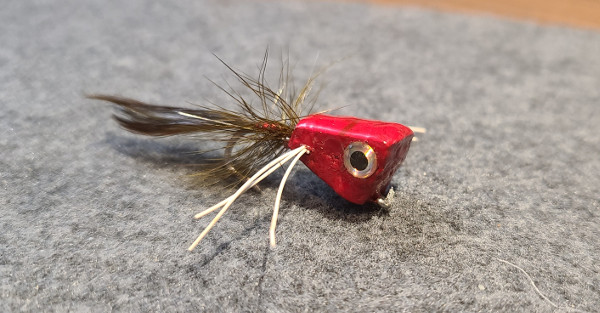
Popper flies come in a wide variety of materials and patterns. While there are key differences in presentation between deer hair, balsa wood, cork, and foam poppers, they all serve the same basic purpose. To float the fly, make a satisfying POP when retrieved, and get the attention of the fish. The idea is to imitate something in distress. If you want some ideas on specific popper fly patterns, check this post out.
Poppers are really good at getting a fish’s attention, and many bass with smash a popper quite readily. Sometimes the fish are a bit pickier, and will just stare at the popper, but refuse to commit. Before changing flies, try changing the retrieve. Specifically, wait for a (painfully) long time between strips, at least long enough for the ripples from the fly to dissipate. If you find you’re getting the fish’s attention but they’re not committing, try switching to one of the more subtle presentations listed here instead.
If you can still see that the bass isn’t committing, try putting a dropper fly (nymph or streamer) off the end of the popper, there’s a good chance the bass will take the secondary presentation after the popper has drawn its attention.
Moorish Mouse
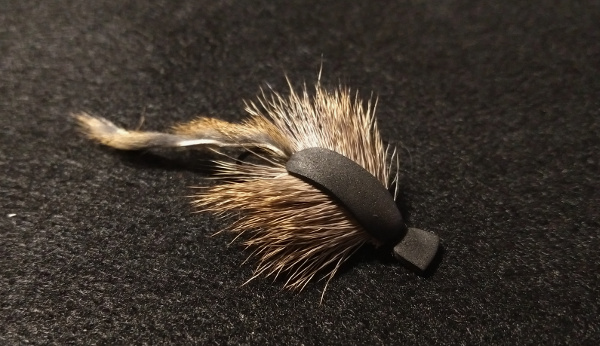
Mice find their way into the water all the time. Both accidentally, and on purpose to cross the water. Mice are surprisingly accomplished swimmers but are still quite vulnerable while swimming along the surface of the water.
Mice patterns tend to be more effective later in the evening or low-light conditions, as most rodents are more active at night.
Sure you can tie more elaborate mice imitations, but the bottom of the fly is all the fish sees when fishing topwater. The Moorish mouse gives a good silhouette at the water’s surface while remaining more streamlined to cast than many other mouse flies.
Sneaky Pete
This is another topwater pattern that’s a bit more subtle than a typical popper. Much like the gurgler, this pattern is best used on skinny water to target heavily pressured/cautious fish. The fly is much
The action is distinct from any other topwater fly, and will very often trigger a strike from smallies. Retrieve with short sharp strips with long pauses inbetween.
A how-to on tying this pattern can be found here.
Dries
In addition to critters, smallmouth bass also eat insects off the surface. The insects that are targeted by bass tend to be bigger than the usual flies imitated when dry fly fishing for trout.
Damselfly & Dragonflies
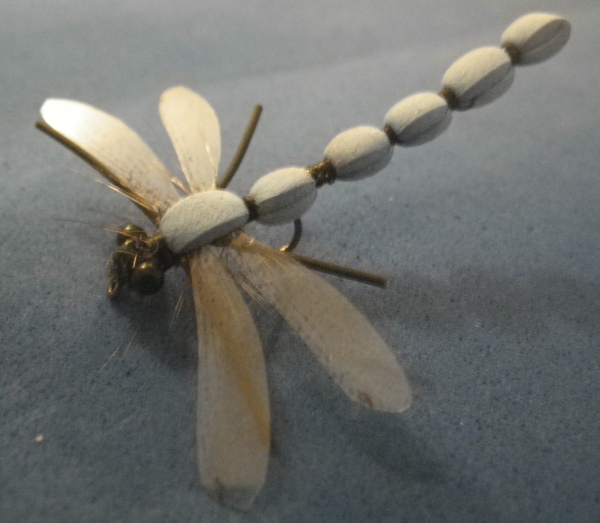
Dragonflies do a good job of staying out of the water most of the time. When they do get waterlogged though, they’re extremely vulnerable. Damselflies stuck in the water struggle quite a bit, drawing a bass’s attention.
Fish these flies with micro twitches along the surface to mimic a struggling dragonfly. Damsel and dragonfly patterns are best fished in slower moving water with healthy populations of these insects. For more damsel and dragonfly fly patterns, click here.
Hoppers
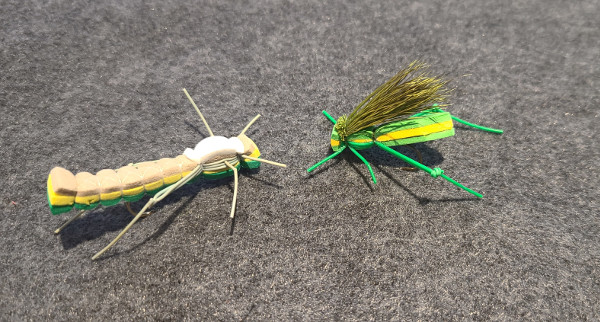
Hoppers are big, juicy meals for any opportunistic fish. They are terrestrial insects that often find themselves accidentally in the water. Whether it be from a mis-aimed jump, or just slipping off overhanging vegetation.
Cast hopper patterns along river banks and overhangs, areas where grasshoppers are most likely to fall into the water. They can then be dead drifted like any other fly, or twitched to mimic a struggling grasshopper. I tend towards foam hopper patterns for smallmouth bass fishing, rather than those made of all-natural materials. The natural materials work too, but most foam patterns are a quicker tie.
Cicada flies
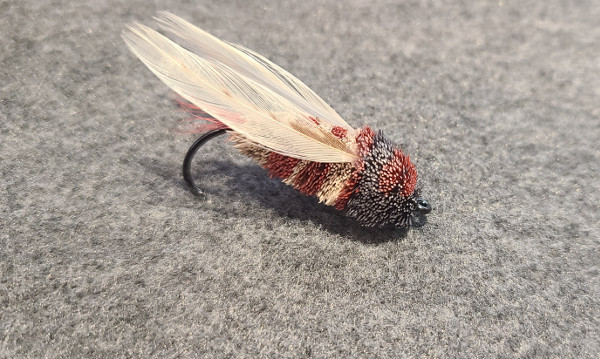
Smallmouth bass will go absolutely nuts for cicadas if there’s a hatch going on. In the right circumstances (IE a cicada hatch), these beefy bugs offer some of the best fishing around. Here’s a dedicated article on some different cicada fly patterns.
The most well-known cicadas are those with cycles in which they hatch every 13-17 years. There are other species of cicada that hatch every year though, so cicada patterns still work well outside of the heavy hatch cicada brood years.
If you find yourself in the middle of a cicada hatch with no cicada flies. A classic bomber fly (sized for atlantic salmon) will do an alright job of imitating these big bugs, if you don’t have any of those, you can try an oversized hopper pattern.
Hexagenia Mayflies
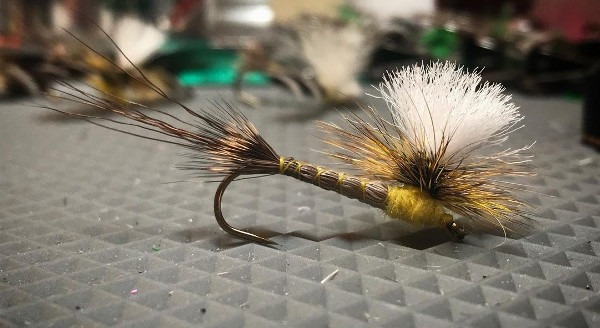
Smallmouth bass don’t typically sip small mayflies like trout do, but some mayfly species (such as Hexagenia and drake) get quite large. Large enough to draw the attention of bass. These large mayfly species will drive smallies wild, especially if there’s a good-sized hatch going on.
Hexagenia hatches give fly anglers an opportunity to target smallmouth bass on traditional (albeit large) style dry flies. If Hexagenia species don’t hatch in your area, check to see if other large river bugs do. Such as large stoneflies, drake mayflies, large caddisflies or salmonflies.
Nymphs
Nymphing is not a widely used technique when fly fishing for bass. That’s a shame as it can be quite productive. I’ve had a few days that were quite slow when fly fishing streamers and poppers. I then tried tying on an indicator and nymph and started catching fish.
No need to euro nymph when targeting bass. The takes are generally strong enough that there’s no issue detecting them, and there’s no risk of the indicator scaring the fish. If you find that fish are striking your indicator, try a hopper-dropper rig instead of an indicator.
Balanced Leech
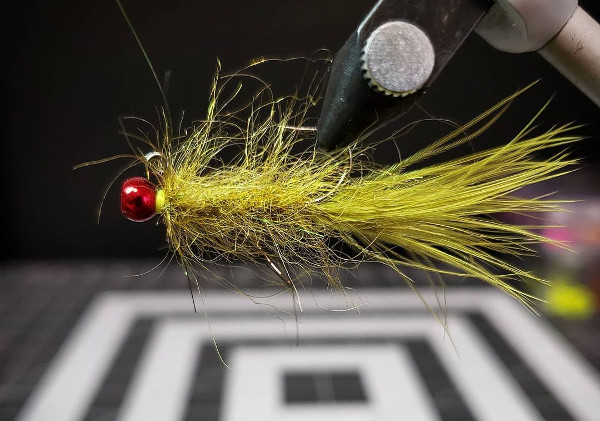
This fly is a hybrid between a streamer and a nymph. It’s basically a streamer tied with the intention to be fished like a nymph. You can fish it like a streamer sure, but balanced leeches really excel when fished under an indicator. They mimic a baitfish or leech suspended in the water column.
The weight tied past the hook eye causes the fly to suspend horizontally when paused. Getting the weight size and placement just right so the fly is balanced takes some practice.
You can also hold presentations in tricker areas (like between two downed logs) longer while using an indicator than you could when fishing a streamer traditionally.
Stonefly Nymphs
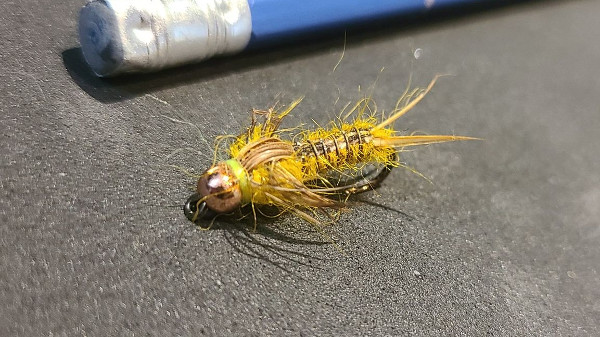
Smallmouth bass don’t typically eat as small bugs as trout (although I’ll go over exceptions further down), but larger nymphs such as stoneflies are still readily taken by even adult bass.
Stoneflies prefer clean, clear, and cool flowing waters. If the river you’re fishing hold trout in addition to bass, there s a good chance stoneflies are around. If the river is too warm for trout, it’s likely too warm for stoneflies as well, so move onto other imitations.
Damselfly and Dragonfly Nymphs
This is another grouping of patterns rather than a specific pattern.
Dragonflies are beefy, and damselflies wiggle in an enticing way, making them two prime targets for bass to pick off. Younger bass feed on these quite heavily, but bigger smallmouth bass will continue to eat these nymphs well into adulthood.
Hellgrammite
Ever see a hellgrammite? They’re big, leggy, nasty bugs. Just the kind of thing that bass love to make a meal of! As a bonus, due to all their legs, you can have quite a bit of fun tying hellgrammite patterns.
If you don’t want to use a dedicated hellgrammite pattern, an appropriately sized black wooly bugger will do the trick.
Hare Ear Nymph
This one might surprise folks, as it’s a classic trout nymph that would often be considered too small for bass fly fishing. The nymph imitates a wide variety of prey items “good enough” rather than one prey type perfectly. As such, it’s been one of my go-to searching patterns for trout for years and works surprisingly well on picky smallmouth bass as well.
Big fish don’t always eat big flies. This is especially true of heavily pressured fish, or fish in gin clear water. Uncut angling shows this first hand in one of his videos. Not only does the nymph work better than the streamer he was using earlier, but he also proceeds to outfish the gear angler with him for a time while using the hare’s ear nymph.

9 thoughts on “Smallmouth Bass Flies – The Best 21”